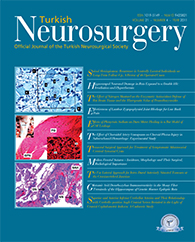Turkish Neurosurgery
2011 , Vol 21 , Num 4
1Kasimpasa Military Hospital, Department of Neurosurgery, Istanbul, Turkey
2Gulhane Military Medical Academy, Department of Neurosurgery, Ankara, Turkey
3GATA Haydarpasa Training Hospital, Department of Radiology, Istanbul, Turkey
4GATA Haydarpasa Training Hospital, Department of Nucleer Medicine, Istanbul, Turkey
5GATA Haydarpasa Training Hospital, Department of Neurosurgery, Istanbul, Turkey DOI : 10.5137/1019-5149.JTN .4473-11.2 AIM: Anterior cervical fusion procedures are among the most commonly performed spinal operations. Investigators have reported pseudoarthrosis rates ranging from 3 to 36% following anterior cervical fusion operations. The diagnosis of pseudoarthrosis has been based on the triad of pain, radiographic evidence of instability, and loss of correction or fixation. Scintigraphic imaging may be involved in pseudoarthrosis investigation by increase of nuclear agent uptake at the operated level but today it is not used in clinical practice as a routine imaging modality.
Corresponding author : Serdar Kaya, serdarockk@yahoo.com
2Gulhane Military Medical Academy, Department of Neurosurgery, Ankara, Turkey
3GATA Haydarpasa Training Hospital, Department of Radiology, Istanbul, Turkey
4GATA Haydarpasa Training Hospital, Department of Nucleer Medicine, Istanbul, Turkey
5GATA Haydarpasa Training Hospital, Department of Neurosurgery, Istanbul, Turkey DOI : 10.5137/1019-5149.JTN .4473-11.2 AIM: Anterior cervical fusion procedures are among the most commonly performed spinal operations. Investigators have reported pseudoarthrosis rates ranging from 3 to 36% following anterior cervical fusion operations. The diagnosis of pseudoarthrosis has been based on the triad of pain, radiographic evidence of instability, and loss of correction or fixation. Scintigraphic imaging may be involved in pseudoarthrosis investigation by increase of nuclear agent uptake at the operated level but today it is not used in clinical practice as a routine imaging modality.
MATERIAL and METHODS: Nine cases operated for degenerative disc disease on single level but suffering postoperative prolonged neck pain were involved in the study. All cases underwent 99mTc-hydroxymethylene diphosphonate (HMDP) bone SPECT later than postoperative twelfth month.
RESULTS: Results showed a correlation between severity of neck pain and fusion status.
CONCLUSION: Increased and prolonged uptake of nuclear agent should cause a suspicion on so-called fusion, proven by radiology.
Keywords : Cervical fusion, PEEK cage, Pseudoarthrosis, Scintigraphy




